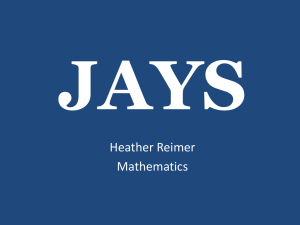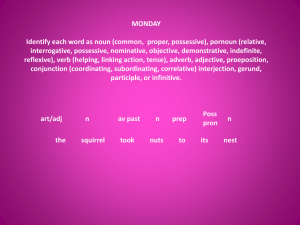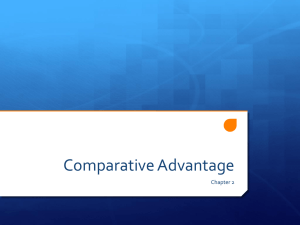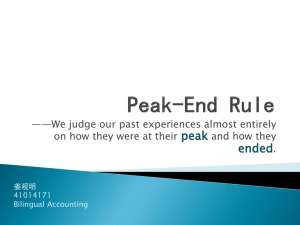Comparative Cognition 2: Special Topics
advertisement
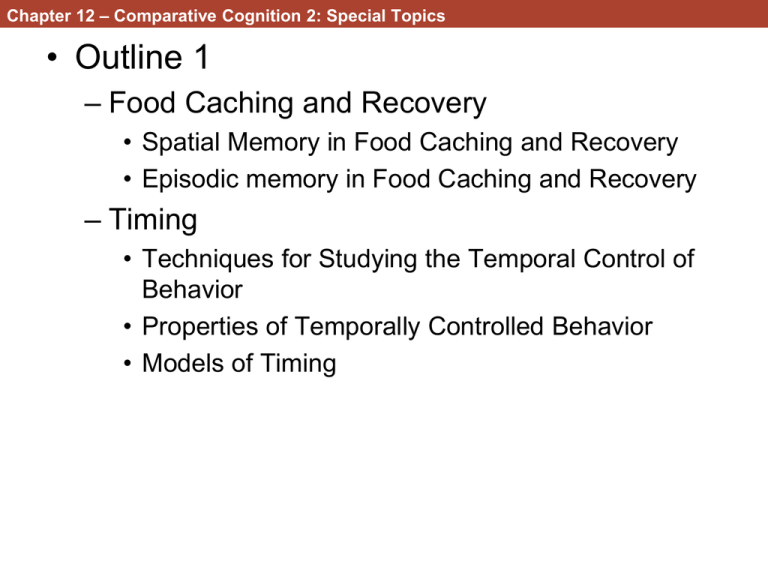
Chapter 12 – Comparative Cognition 2: Special Topics
• Outline 1
– Food Caching and Recovery
• Spatial Memory in Food Caching and Recovery
• Episodic memory in Food Caching and Recovery
– Timing
• Techniques for Studying the Temporal Control of
Behavior
• Properties of Temporally Controlled Behavior
• Models of Timing
• Food Caching and Recovery
• Many animals hide food and then retrieve it later
– Caching
• Blue jays (Cyanocitta cristata)
– store about 2000 to 4000 acorns, and retrieve about 30% of
them.
• Scrub jays (Aphelocoma californica)
– store 4000 to 6000 acorns and pine nuts, and retrieve about 40%
to 50% of them.
• Pinyon jays (Gymnorhinus cyanocephalus)
– store 10,000 to 15,000 pinyon pine (Pinus edulis) nuts, and
retrieve over 50% of them.
• Clark's nutcracker (Nucifraga columbiana)
– stores 22,000 to 33,000 nuts of the whitebark pine, Pinus
albicaulis, in up to 2700 locations over an area of over 100
square miles, and remember where almost 70% of them were
placed
• Food caching has become a rich area of research.
• How do they do it?
–
–
–
–
Search randomly?
Store only in special spots?
mark the area?
Smell the food?
• Controlled laboratory studies indicate none of the above.
– Forced hiding (can’t pick a special spot)
• Cups in the floor.
– Only some are open
– Tested with raked over sand
• Can’t mark it
– Tested with empty cups
• Can’t smell it
– They go to all of the cache locations first (18 out of 180 available)
• Not random.
• They remember where they put the items
• Clayton, Bussey, and Dickinson (2003)
– used food cacheing scrub Jays to examine
episodic memory
• Endel Tulving
– Episodic memory is uniquely human
– Mental time travel
• Relive the past
– Specific characteristics?
• Remember what happened
• Remember where it happened
• Remember when it happened.
• Can we find evidence of such abilities in
animals?
• Scrub Jays hide perishable and non perishable items
– Grubs
– Nuts
• They taught the Jays that Grubs go bad after a week.
– Hide grubs
– Allowed to find four hours later
• Good grubs
– Allowed to find five days later
• Rotten grubs
• The nuts were good regardless of when they were
hidden
• Another important fact
– Scrub jays like grubs better than nuts
• If fresh
– They prefer nuts over rotten grubs
• Allow the jay to hide grubs and nuts
– One ice tray at a time (grubs or nuts)
• Trays made distinctive with blocks
• Hide grubs in one tray
• Nuts in the other
• Test 4 hours later with both trays
– Which do they go for first?
• Test 5 days later with both trays?
– Which do they go for first
• Indicates the Jays remembered
– what they hid
• grubs or nuts
– where they hid them
• the specific spots on the tray
– when they hid them
• 4 hours vs. 5 days
• Often referred to as Episodic-like memory
– Still a lot of debate on whether it is the same as human
episodic memory which has a conscious component
• Self concept
• Clayton has shown in more recent work,
that Jays that are experienced at stealing
from other Jays will move cached food if
they know they are being watched by
other jays
– After the other jay is removed, they move it
– Those that are not robbers are less likely to
move cache’s when observed
• Too trusting?
• Timing
• Duration matching to sample
– White key is presented on the center
– 2s R+G– 8s R- G+
• Animals can quickly learn this
discrimination
• What is the point of subjective equality?
– What sample duration is equally called short
or long?
• Test with new sample durations?
– 3, 4, 5, 6, 7?
• tends to be the geometric mean
– √2x8 = 4
• Implies that organisms view time in terms of
relative values rather than absolute values
– Absolute values
• There is a 6s difference between 2s and 8s
– 3s is half of 6s
– So you would expect point of subjective equality to be at 5s.
» 2+3
» 8-3
– Relative values
• 4 is twice as long as 2
• 4 is half as long as 8
• All organisms studied (including humans) seem to
view in terms of relative values.
– 3 vs. 9 seconds (3x as long) same as 9 vs. 27
seconds (also 3x)
• Known as scalar invariance
• Does time pass more quickly when we are
busy?
– Pigeons?
• Zentall, Friedrich, & Clement (2005)
– White timing stimulus (2s vs 10s)
• Required pecking (at least 1 per second) or trial
terminated
– Blue timing stimulus (2s vs 10s)
• Do not peck for the duration of trial terminated
•Look at the point of
subjective equality
•Pecking pigeons
•about 5.5 s
•2, 3, 4, and 5 s all
fall on the short side
of the line
•Non pecking pigeons
•just over 4s
•only 2, 3, and 4
were judged to be
short
•Thus, time passed more
quickly when they were
busy pecking.
•
•
•
•
Memory for time?
Duration matching to sample with delays
2s {Delay} R+G10s {Delay} R-G+
•The choose short effect
•Why does this happen?
•Subjective shortening?
•Instructional ambiguity?
•Delay interpreted as an ITI?
•No sample?
•Is no sample more
similar to short or long?
•What happens if we make the Retention Interval (RI) distinct from the ITI?
•House light lit during ITI
•dark during RI
• The Peak procedure
– Phase 1
• FI 30
– With ITIs (variable)
– Phase 2
• FI 30
• Probes (peak trials)
•Curves for FI 40
•Peak at 40s
•Curves for FI 20
•Peak at 20s
•FI 40 curve twice as wide as for FI 20
• Scalar expectancy theory
– Gibbon and Church
– Animals peak responding occurs when they
expect RF
– The variability in response rates is
proportional to the value of the reinforced
interval
– Consistent with the scalar invariance we
discussed in terms of the point of subjective
equality earlier
•The hypothesized internal clock
•The pacemaker generates pulses
•When a signal occurs the switch
closes.
•Pulses from the pacemaker begin
to fill up the accumulator
•like sand in an hour glass
•Reference memory holds the
average amount of pulses (sand)
that has led to RF in the past
•Working memory keeps track of
number of pulses (sand) currently
accumulated
•Comparator “compares” working
memory to reference memory.
•when sufficiently similar the
organism responds.
• What if you speed up the clock?
– Increase pulse generator
• Stimulant drugs
– Peak shift?
• To the left
• Slow it down?
– Decrease pulse generator
• Depressant drugs
– Peak shift?
• To the right
• Flexibility of the internal clock
– Stopwatch model
– Evaluated with gap trials
• 10s gap 10s in
– Time through
– Reset
– Pause
• Tend to find something in between Pause
and Reset
• Behavioral Theory of Timing
– (Killeen and Fetterman)
– This is the main alternative to scalar expectancy
theory.
– It also posits a clock (pulse generator)
– Somewhat less cognitive
• Less focus on memory systems (working vs reference).
– The focus is on how the animal behaves during
the timing episode
• Sequences of behaviors that lead up to reinforcement
• Similar to behavioral systems (Timberlake) we
discussed earlier
– Remember superstitious behavior?
» Post food-focal search
» General search
» Prefood–focal search
• Outline 2
– Tool Use in Nonhuman Animals
– Language Learning in Nonhuman Animals
• Early Attempts at Language Training
• Language Training Procedures
– Self Awareness in Chimps
• Kohler was an early researcher of animal
tool use
• He gave chimps problems to solve
• Kohler didn’t agree with Thorndike’s
conclusions about animal intelligence
– Unfair test?
• Cat couldn’t see the entire mechanism to get them
out of the box.
– Much was hidden from them
– How could they possibly use insight.
• Kohler did not have hidden mechanisms
• New Caledonian crows are known to use
tools in the wild.
• They have also been studied in the lab
and have shown impressive tool use
abilities.
Video
Video
• Kanzi and lexigram
• Kanzi and novel sentences
• Self recognition in chimp (important part
starts at 1.44)
